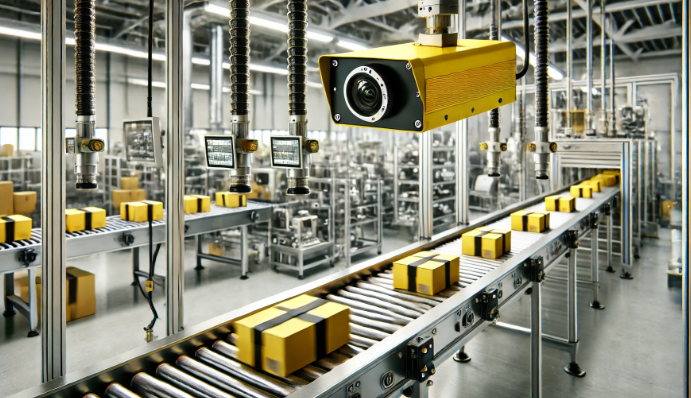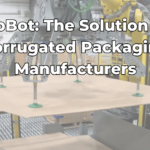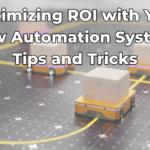Machine vision uses advanced cameras, specialized lighting and sophisticated software algorithms to capture and analyze visual information in your manufacturing processes. It acts as the “eyes” of your automated systems, enabling real-time inspection, measurement and decision-making.
These systems can process vast amounts of visual data quickly and accurately, far surpassing human capabilities. By translating visual information into digital data, machine vision enables your automated systems to make informed decisions and take appropriate actions in real time.
Key Benefits of Machine Vision in Manufacturing
Enhanced Quality Control
Machine vision systems can detect defects and inconsistencies imperceptible to the human eye, ensuring your products meet the highest quality standards. This technology works tirelessly, maintaining consistent inspection criteria 24/7.
By implementing machine vision, you can significantly reduce the risk of defective products reaching customers, enhancing your brand reputation and customer satisfaction. For you as a manufacturing leader, this means fewer customer complaints, reduced warranty claims, and improved brand reputation.
Increased Efficiency and Throughput
By automating visual inspection tasks, machine vision significantly speeds up your production lines. It can process hundreds of items per minute, far outpacing manual inspection methods.
This increased speed doesn’t come at the cost of accuracy. In fact, machine vision systems often improve your overall quality while dramatically increasing production rates.
Reduced Costs and Waste
Early detection of defects prevents faulty products from moving further down your production line, saving materials and resources. This proactive approach minimizes waste and cuts your operational costs.
Additionally, machine vision can optimize your material usage and reduce over-processing, leading to significant savings in raw materials and energy consumption. This can significantly impact your bottom line, potentially saving millions in annual operating costs for large-scale operations.
Improved Traceability
Machine vision systems can track and record detailed product information, enhancing traceability throughout your manufacturing process. This data is invaluable for your quality assurance and regulatory compliance efforts.
In industries with strict regulatory requirements, such as pharmaceuticals or food production, this traceability can be crucial for meeting compliance standards and managing potential recalls efficiently.
Applications Across Industries
Machine vision’s versatility makes it valuable in diverse manufacturing sectors:
- Automotive: Inspecting component quality, guiding robotic assembly
- Electronics: Ensuring precise placement of microscopic components
- Food and Beverage: Verifying packaging integrity, sorting produce
- Pharmaceuticals: Confirming correct labeling, detecting contaminants
- Building Materials: Inspecting surface quality, dimensional accuracy
Each industry leverages machine vision in unique ways, tailoring the technology to address specific challenges and quality requirements.
The Power of AI-Enhanced Machine Vision
Advancements in artificial intelligence are taking machine vision to new heights. AI-powered systems like the OASIS (Optical AI Surface Inspection System) from 20/20 Robotics can be trained to distinguish between good and bad products, much like training a human inspector. This flexibility allows you to adapt quickly to new products or quality criteria.
AI-enhanced machine vision systems can learn from experience, improving their accuracy over time. They can also handle complex inspection tasks that require nuanced decision-making, further expanding the capabilities of your automated quality control.
Integrating Machine Vision: Key Considerations
To maximize the benefits of machine vision, as a manufacturing leader, you should consider:
- Partnering with Experts: Work with experienced integrators who understand your specific industry challenges.
- Customization: Ensure solutions are tailored to your unique production environment.
- Scalability: Choose systems that can grow and adapt with your changing needs.
- Training: Invest in operator training to fully leverage the technology’s capabilities.
Successful implementation often requires a holistic approach, considering how machine vision will integrate with your existing systems and processes.
The Future of Machine Vision in Manufacturing
As machine vision technology continues to evolve, you can expect:
- Greater integration with AI and machine learning
- Improved 3D imaging capabilities
- Enhanced collaboration with other smart factory technologies
- Expanded applications in predictive maintenance
These advancements promise to further enhance the role of machine vision in driving your manufacturing innovation and efficiency.
Machine vision has become a necessity for maintaining competitiveness in today’s manufacturing landscape.
Discover how machine vision can elevate your manufacturing operations. 20/20 Robotics specializes in cutting-edge machine vision solutions tailored to your unique challenges. Contact us today to learn how we can help you achieve new levels of efficiency, quality and profitability.
Frequently Asked Questions
How does machine vision differ from human visual inspection?
Machine vision systems can work continuously without fatigue, maintain consistent inspection criteria and detect defects beyond human visual capabilities. They process information much faster, significantly increasing inspection speeds. Unlike human inspectors, machine vision systems don’t experience fatigue or distractions, ensuring consistent quality over long production runs.
What industries benefit most from machine vision?
While machine vision has applications across manufacturing, it’s particularly valuable in industries with high precision requirements or strict quality control standards, such as automotive, electronics, pharmaceuticals, and food and beverage production. However, as the technology becomes more accessible and versatile, its benefits are being realized in an increasingly wide range of manufacturing sectors.
How does AI enhance machine vision capabilities?
AI allows machine vision systems to learn and adapt, improving their ability to recognize complex patterns and make nuanced decisions. This enables more flexible and sophisticated inspection processes that can evolve with changing product lines or quality standards. AI-enhanced systems can also handle variations in lighting, product orientation and other environmental factors more effectively than traditional machine vision systems.
What’s the return on investment for implementing machine vision?
While the initial investment can be significant, many manufacturers see ROI within 12-18 months through improved quality, reduced waste, increased throughput and labor savings. The exact timeline varies based on the specific application and implementation. Factors influencing ROI include the complexity of the inspection task, production volume and the cost of quality issues that machine vision can prevent.






